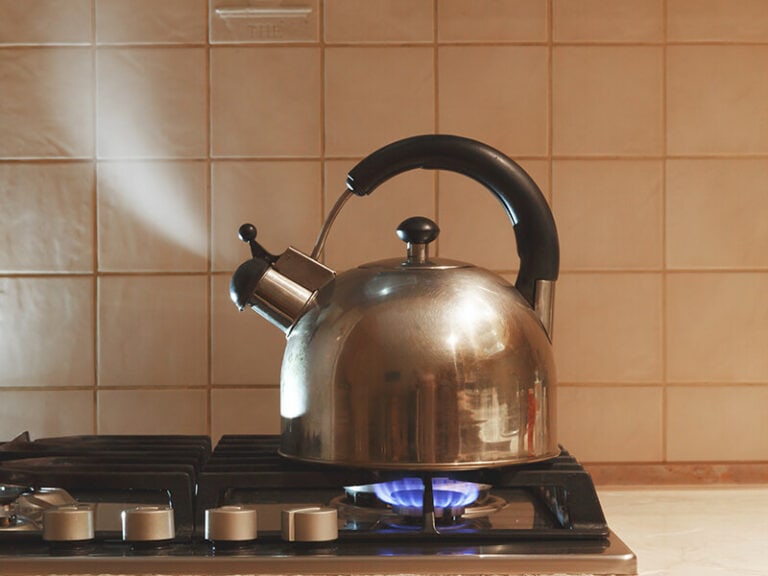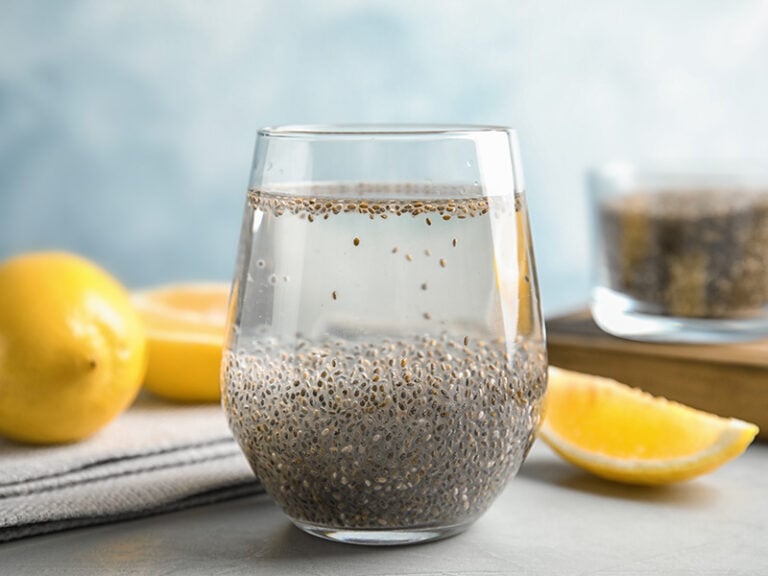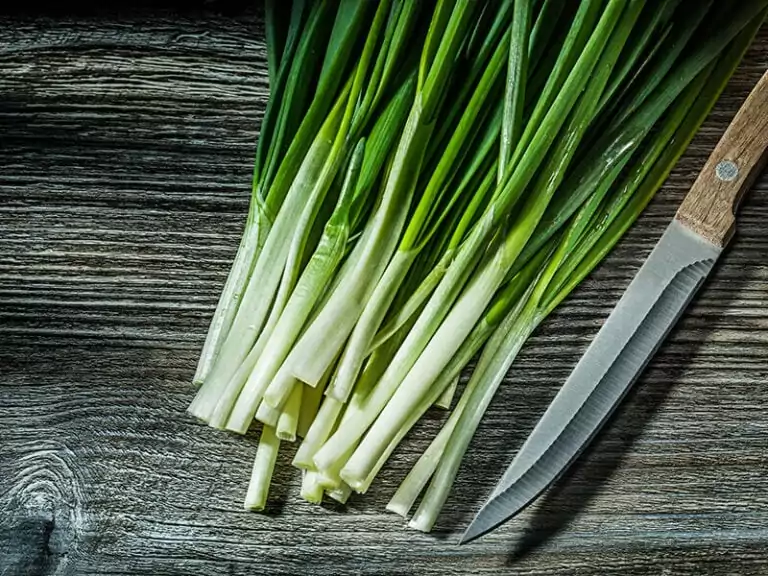What is a stock pot? You cannot understand the importance of having a stock pot in your kitchen if you are not sure what a stock pot is and what it is suitable for. The legendary French chef Aguste Escoffier once said, “stocks are the keynote of culinary structure.”
But this kitchen tool can do more than just cook stock. Whether it is family gatherings, parties, or friendly hangouts, a stock pot is just the right cookware for the job.
However, most people are reluctant to spend money on large kitchenware like a stock pot because they are uncertain about its use. In this article, I will tell you what a stock pot is and why you need at least one in your kitchen.
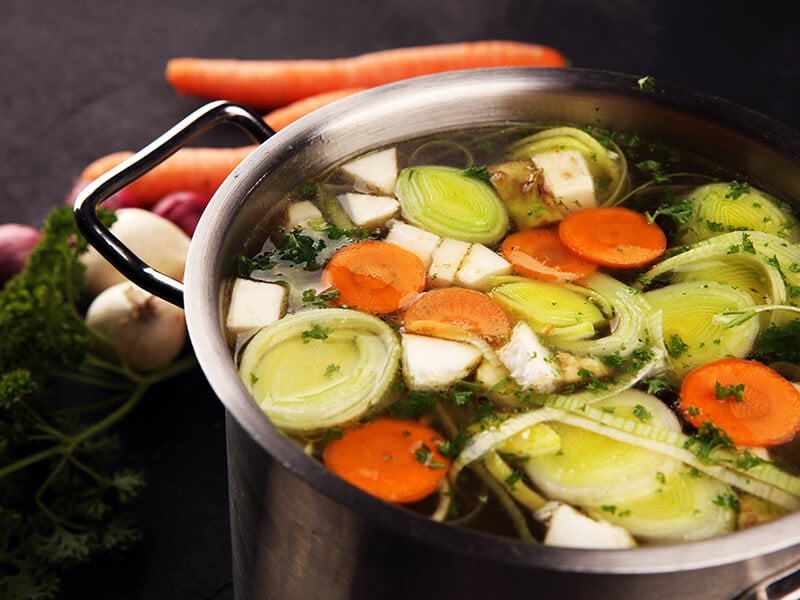
Everything You Need To Know About Stock Pot
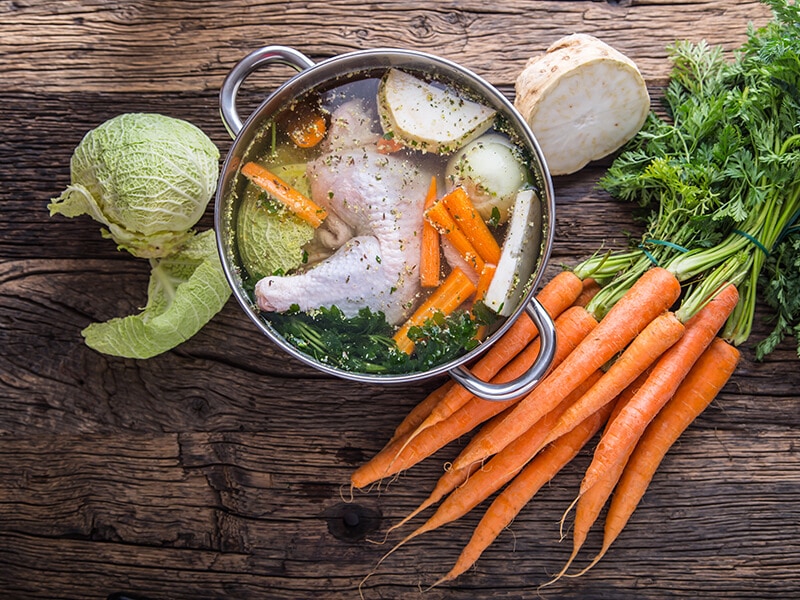
A stock pot is a large, wide, and circular pot with a high wall that can cook a great volume of food. The bottom is flat, with two handles on opposite sides and a lid with a top handle to cover the pot. (1)
Designed for cooking large batches of food, a stock pot is the largest cookware in any kitchen. A stock pot is super durable and versatile in use. The best recipes that stock pots can handle are stocks, soups, stews, pasta, steamed vegetables, or sauce.
Stock pots are perfect for cooking broth and large batches of food. They are great for family gatherings or small parties at home. Whether you want to make chicken soup or a lot of Italian pasta, you should have this tool at your service.
Stock pots are made with a variety of materials, with each material varying in quality and price. Stainless steel is the most common material in stock pots due to its durable and non-reactive nature.
Aluminum is the lower-quality variant and more economical. This metal is less durable and more reactive to elements, so it can affect the taste of your foods. I will cover more materials for making stock pots in the upcoming sections.
Learn about the qualities you should look for in choosing the best pots for your kitchen!
What Defines A Good Stock Pot?
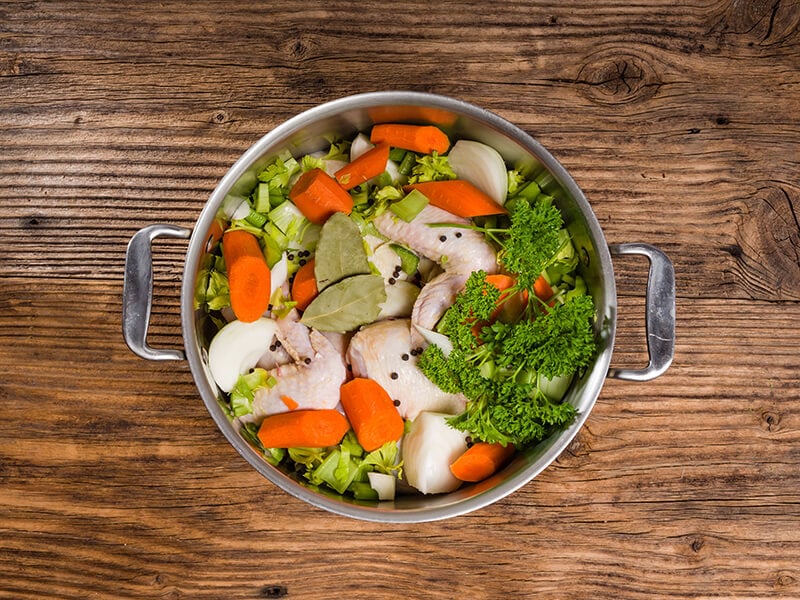
On a search for the perfect stock pot for a long while, I have come to an unfulfilling but truthful conclusion: No stock pot is completely perfect; some are more suitable in certain aspects than others. Price is not the only factor that dictates the quality of a stock pot.
Learn about the best stock pots to add some to your cookware collection.
Size
Size doesn’t define the quality of a stock pot. However, the right size stock pot can improve the quality of your cooking and space efficiency.
Stock pots are not measured in width and height but in volume or the amount of liquid they can hold. People measure the size of stock pots in quarts (1 quart is equal to 32 ounces or 0.94 liter).
There are plenty of sizes, but stock pots for household usage usually come in 4 main sizes: 6-quart, 8-quart, 12-quart, and 16-quart. The volume can even go up to 40 quarts. Each size offers a different serving capability, and some are better for certain dishes than others.
A 6-quart stock pot offers 12 servings in a batch, and it’s good for cooking stock, pasta, soups, stews, and curries. A stock pot with a volume of 8 quarts can perform the same task, but it, of course, can handle a larger amount of food.
Meanwhile, you can cook for 24 – 26 people with 12 – 14-quart stock pots. They allow you to prepare an even larger quantity of stock. Even better, if you want to steam whole lobsters, corn cobs, or large chunks of meat, these large pots are an excellent choice.
People rarely use extra-large stock pots for household uses. 20 – 40-quart ones are for canning, brewing beer, or preparing food in restaurants.
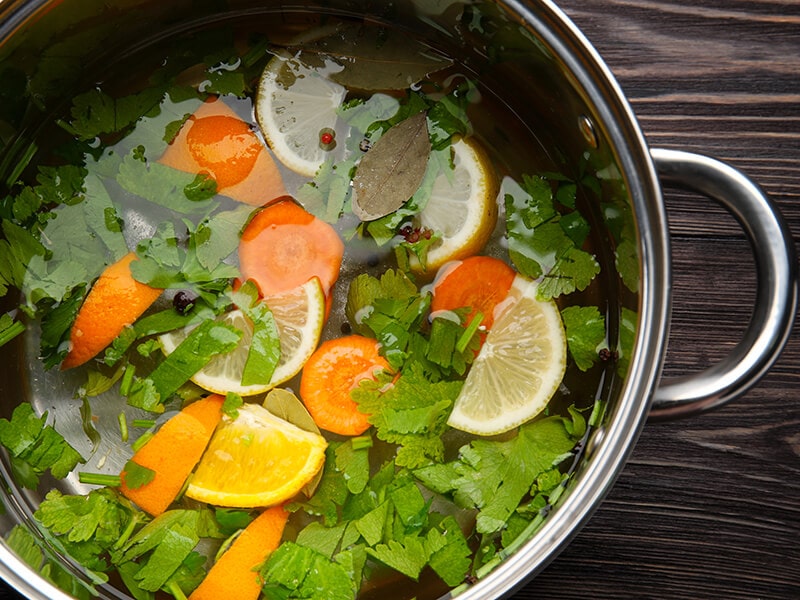
Material
The material of a stock pot directly affects its quality. Each material comes with its advantages and disadvantages. Here are some common materials in stock pots:
Stainless Steel
Stainless steel is a popular material used in stock pot manufacture due to its durability and good heat conduction capability. A stock pot with good heat conduction will distribute the heat evenly inside the pot and cook your food more efficiently.
Stainless steel is also a non-reactive material, which doesn’t react with elements in foods and alter their taste or cause discoloration.
In an environment such as a kitchen, cookware should come with good durability to withstand heat and bumping without changing its original qualities.
In that sense, stainless steel is the best choice for its hardness and durability: this metal is resistant to scratches and dents. It’s also lightweight and easy to clean.
Non-Stick
Many non-stick stock pots are made of aluminum, though stainless steel is another popular choice. The non-stick layer of the pot prevents food from sticking to the base.
With non-stick stock pots, you have to be extra careful since the non-stick layer can be damaged by impact from other things, like metal utensils.
Aluminum
Aluminum is the second most popular material in the stock pot market due to its affordable price. Aluminum is good at heat-conducting, which makes it easier to spread heat evenly in a shorter amount of time. This gives aluminum a more favorable choice in large-scale cooking. (2)
Aluminum is softer and more lightweight than stainless steel, which makes it easier to carry. However, a lower price also means more downsides. The problems with aluminum are its soft nature and high reactivity.
Its softness makes it more prone to scratches and staining, while being a reactive metal causes it to interact with elements in foods, thus changing its flavors and colors. Also, aluminum is very vulnerable to dents which can lead to instability in heat conduction.
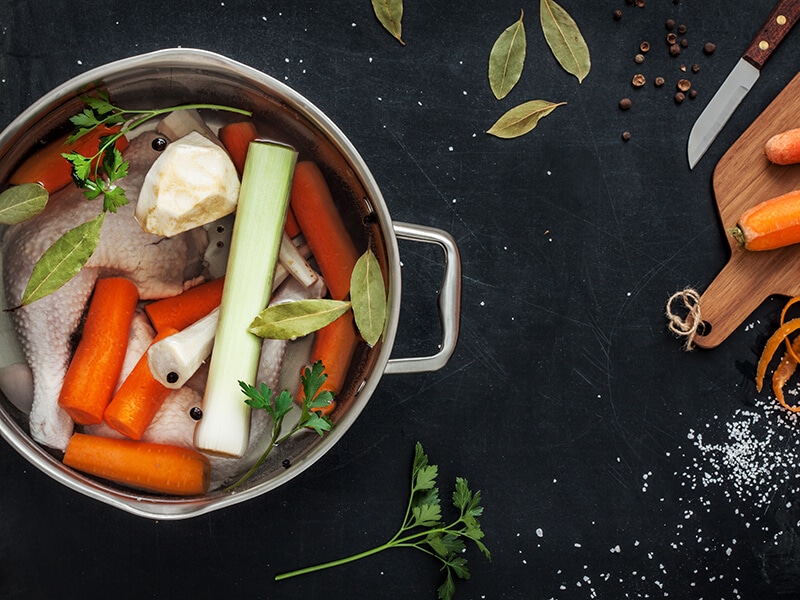
Hard-Anodized Aluminum
Hard-anodized aluminum stock pots are made from electrochemically-treated aluminum. This enhanced aluminum is more sturdy than normal stainless steel and better at resisting scratching.
This material is relatively non-stick and non-reactive to foods. It’s also oven safe and easy to clean. This type of pot is heavier than traditional aluminum stock pots due to its coating. You shouldn’t wash anodized aluminum in a dishwasher.
Iron-Clad And Ceramics
There are also more durable materials in the market, such as iron-clad and ceramics. An iron-clad pot is fairly heavy, but it’s not very likely to show any sign of damage even when you drop them.
On the other hand, although ceramics are durable, they can break or crack when getting bumped or dropped.
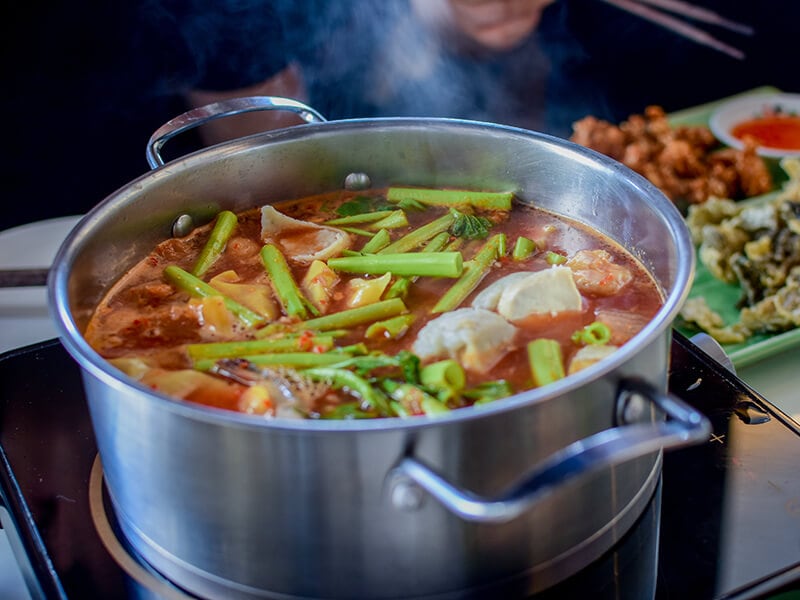
Multi-Clad
Multi-clad pots come with multiple layers of different materials (up to 7 layers). A tri-ply pot is also a type of multi-clad pot. This type of pot tends to be heavier, but it is also much more durable and resistant to impact or stains.
Multi-clad pots include an aluminum core to conduct and distribute heat evenly, with outer layers being stainless steel and cladding on the sides. Multi-clad pots can be used on the stovetop and in the oven.
Porcelain-Enameled Steel
Porcelain-enameled stock pots are made of good quality carbon steel coated with porcelain enamel. They are lightweight, durable, and safe to use in an oven or dishwasher.
Some pots come with a stainless steel rim to reinforce durability. This kind of pot is good at distributing heat evenly and quickly.
They don’t react to acidic foods and are quite non-stick. However, the colorful enamel exterior is prone to chip or crack with strong impact. Porcelain-enameled stock pots are not dishwasher safe.
Porcelain-enameled stock pots usually have a seamless coating with heatproof handles on both sides and on the lids.
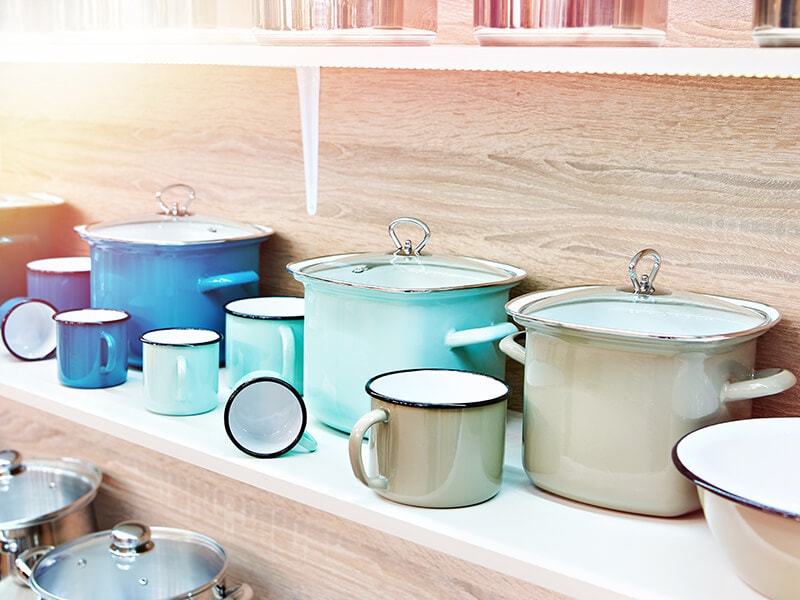
Heat Conduction
Heat conduction is a common criteria to judge a stock pot. This quality can directly affect how your food is cooked and how much time it takes to finish your food. In this aspect, there are three factors you should consider: size, construction, and material.
Bigger stock pots will need more time to heat up evenly than smaller ones since they have more space for the heat to reach. 6-quart stock pots boil water the fastest.
A stock pot has a unique construction of a narrow base and tall sides, which means the base takes less time to heat up and the heat will reach all parts of the pot faster.
Lastly, material plays an important role in heat conduction too. Aluminum and hard-anodized aluminum are very good at conducting heat, superior to stainless steel in that aspect.
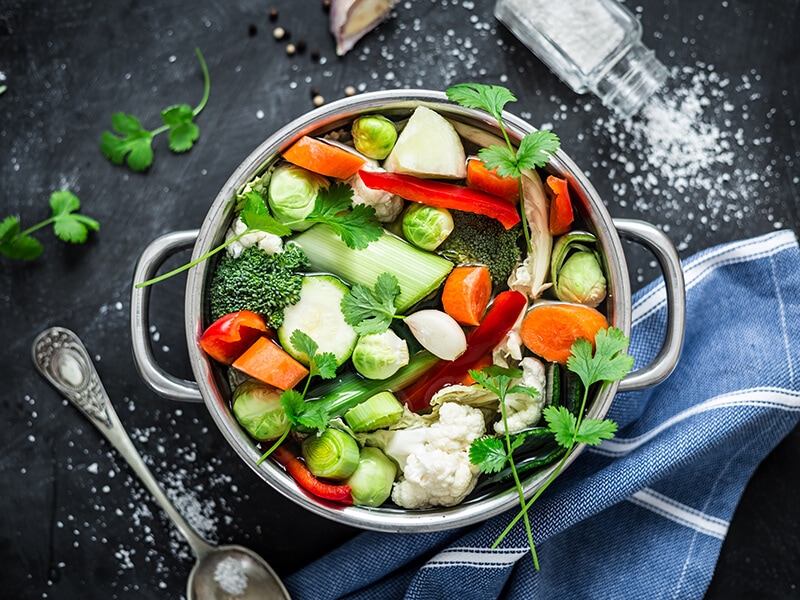
Affordability
Price is also a criterion to define a good stock pot. Stainless steel bestows high quality on any stock pot, which, in return, results in a higher price. Aluminum and non-stick pots are cheaper, but they come with some downsides.
Hard-anodized aluminum stock pots are more expensive than aluminum pots, but they cost less than stainless stock pots. Multi-clad and porcelain-enameled stainless steel stock pots are among the most expensive.
Regarding price and quality, stainless steel pots are the best choice for a household kitchen. They can last a lifetime if you keep them properly, making a sure-win investment for your kitchenware.
You Should Pay Attention To These Special Features Of Stock Pots
Certain stock pots come with remarkable features that assist you a lot in your kitchen work. Here are some notable features:
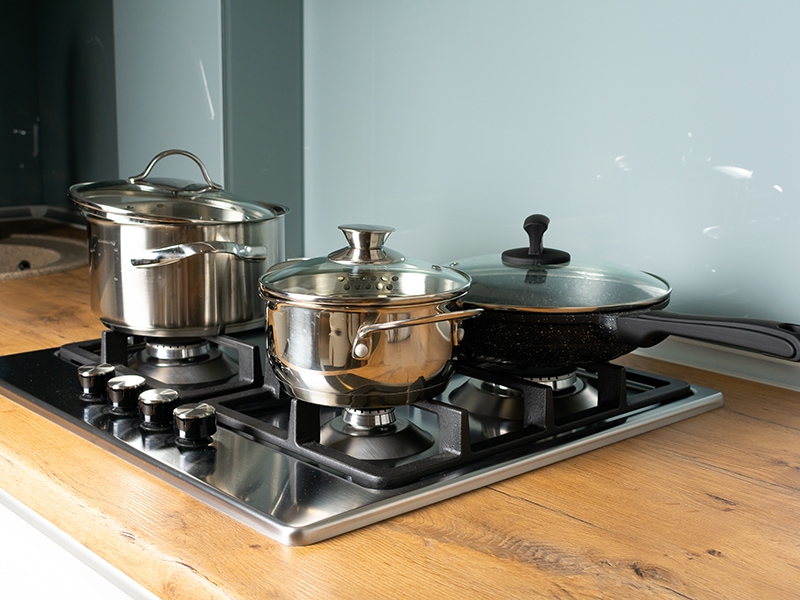
Tight-Fitting Lids
Lids are essential to retaining heat in any kind of pot. Lids in stock pots are good for preventing plashes as the base bubbling also. Lids usually come in 2 options: glass lids and metal lids.
With a glass lid, you can see the contents and monitor cooking better. But a lid made of stainless steel is more durable and expensive.
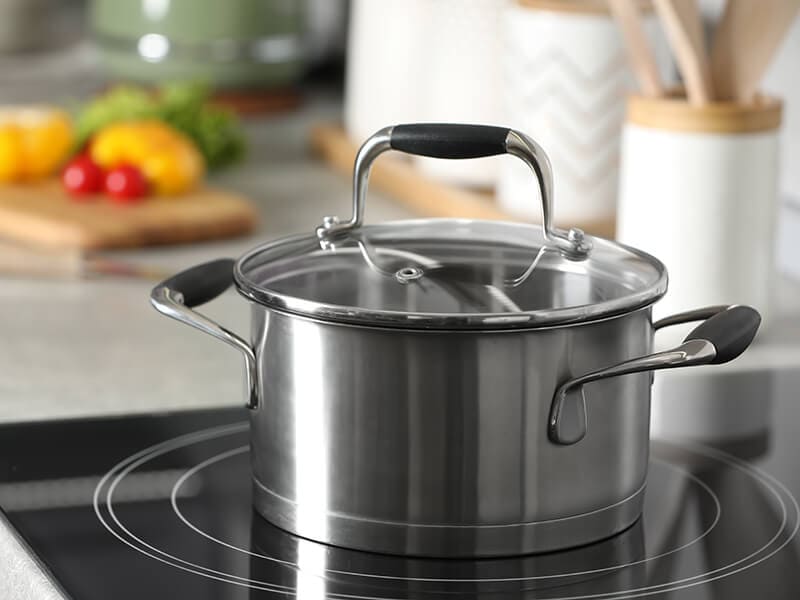
Oven-Safe
Not every stock pot is safe with an oven, especially the glass and ceramics kinds. If you want to use your stock pot as a food container to put into the oven, look for some kind of oven-safe stock pot. Those stock pots are more resilient in high temperatures than others.
Most metal pots, such as aluminum, stainless steel, or cast-iron pots, are safe in the oven.
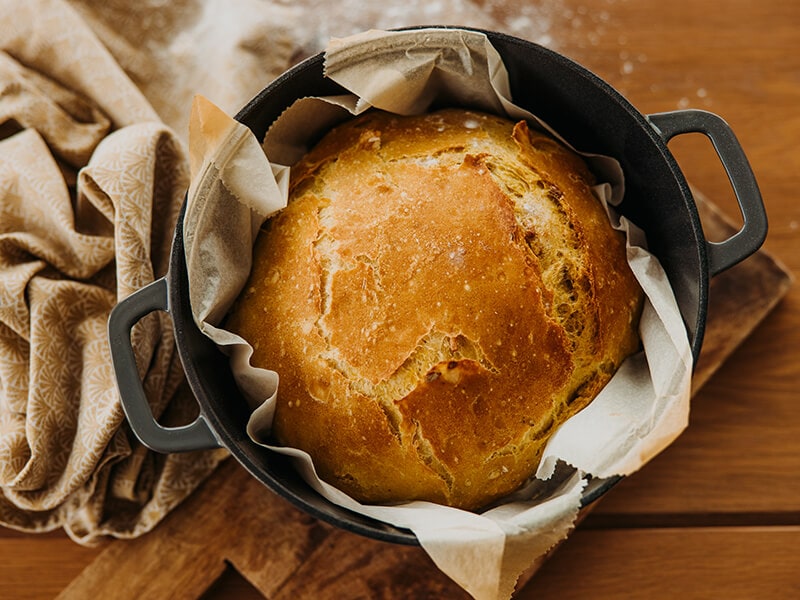
Dishwasher-Safe
If you own a dishwasher, it’s better to check if your stock pots will be fine in a dishwasher. Most aluminum and stainless stock pots are safe in dishwashers. Some heavier glass stock pots are not suitable for dishwashers.
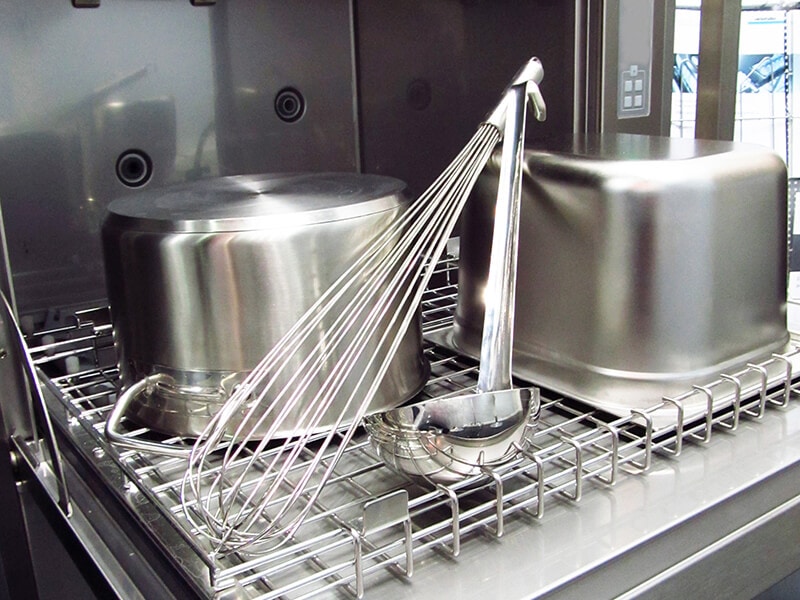
Heatproof Handles
Made of stainless steel and plastic wrap, heatproof handles will prevent your hands (as well as your children’s) from getting burnt by the heat from the pot. But not every stock pot comes with this feature.
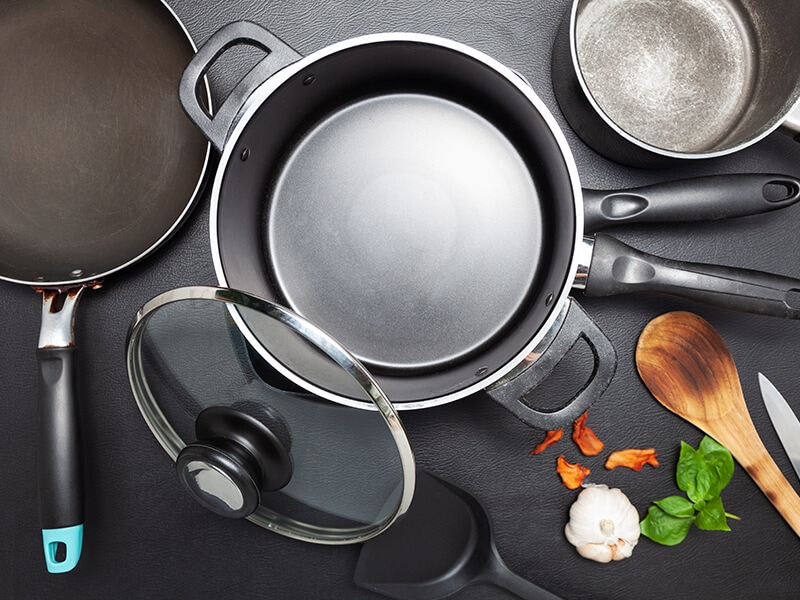
Strainer
A strainer is extremely handy when you want to strain your ingredients out dry and clean without touching the water, especially with pasta or macaroni. Some stock pot brands include strainers in the purchase.
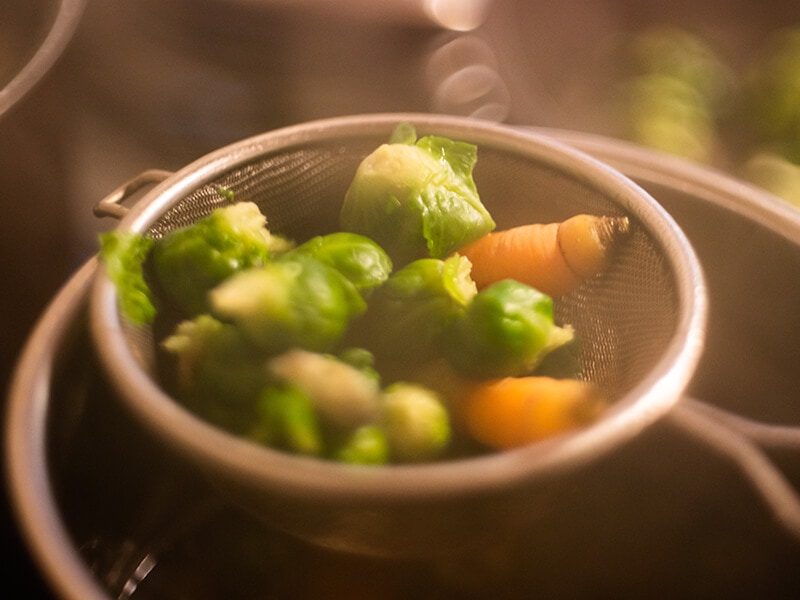
Enamel
Enameled stock pots are made with metal and coated with a layer of enamel to further increase durability and prevent scratches. Enameled stock pots come in many colors, unlike normal steel pots.
Stackable Feature
If your kitchen space is a bit small, stackable stock pots are there to solve your storage problem. These features enable your set of stock pots to be stacked, thus only taking up one space in your cabinet. Your stock pots are also in a better storage condition that way.
Best Stock Pot Brands To Buy
There are various brands that you can choose to get your new cookware from. Here are the best recommendations that I can give:
All-Clad
All-Clad is one of the most trusted cookware suppliers out there. I recommend you buy this Stainless Steel Tri-Ply 8-quart stock pot. It has a wide base for sauteing before cooking. The tri-ply construction is super durable and good at heat conducting.
Opt for a 6-quart stock pot if you need a smaller one for your kitchen. The product is worth any dime spent.
Le Creuset
Le Creuset’s enameled stock pots are the most well-known for their quality. Go for a Le Creuset enamel on steel 8-quart stockpot if you are looking for a beautiful stock pot with good durability.
Tramontina
Tramontina is a more affordable brand for household use. If you are looking for a good stock pot at a reasonable price, go for this Tramontina hard anodized 8-quart stock pot.
People who prefer ceramic stock pots should check out this Tramontina ceramic 6-quart stock pot. With a copper porcelain-enameled pot like this one, you won’t have to worry much about keeping it clean.
Cuisinart
Cuisinart is extremely versatile when it comes to cookware. Take a look at this Cuisinart 6-Quart stainless stock pot with a high impact bonded base and good heat conduction. A tempered glass lid and handles are an added bonus.
Types of Kitchenware That Are Similar To Stock Pots
If you need to cook a large batch of food but no stock pot is around, there are some other types of cookware that you can use as alternatives.
Shape And Size
From the table, you can see these look-alike cookwares have some aspects that set them apart. Stock pots have narrow bases and super tall sides to hold a lot of liquid inside, while soup pots have wider bases with a little shorter sides to hold denser content like soup.
Dutch ovens are as wide as stock pots, but their sides are much shorter. As for saucepans, they are both narrow and squat.
About the average size, a stock pot is the largest pot in the kitchen, whereas a soup pot, a saucepan, and a Dutch oven are relatively the same size.
Weight And Material
Regarding the weight of cookware with the same volume and material, a stock pot is quite light due to its thin base, while the rest are heavier. A Dutch oven is the heaviest tool because of its cast-iron material.
That feature makes Dutch ovens very special. Because they are made almost exclusively of cast iron, they can withstand high heat (up to 450°F). Meanwhile, other types of pots come in a variety of materials, such as stainless steel, aluminum, or ceramics.
Other Features
Judging by the name, you can tell that stock pots are good at cooking stock, soup pots are best for soups, and people create saucepans to prepare sauce or small quantities of food. Dutch ovens, on the other hand, are good at slow cooking, such as stews and braises.
Regarding handle design, saucepans have one long-extended handle, whereas the rest come with two handles on both sides.
The last quality is heat conduction. Both stock pots and saucepans have thin bases to distribute heat faster and more evenly to the sides. By contrast, soup pots and Dutch ovens come with thicker bottoms to prevent food from burning.
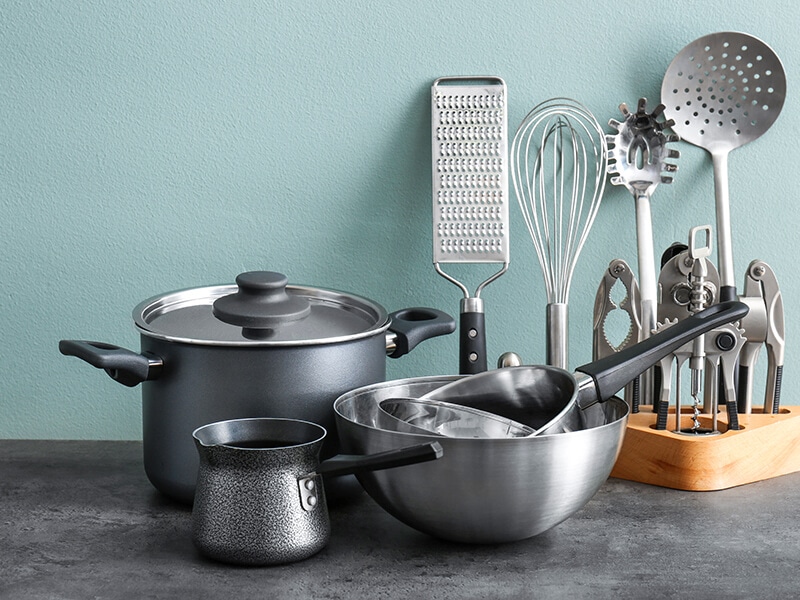
Foods To Cook With Stock Pots
There are tons of foods that you can cook with your stock pot. It’s time to impress your friend and your family with these recipes:
Vegetable Broth
Vegetable broth is easy to prepare, but few people can do it correctly. It’s not easy to keep the crunchy texture and unique taste of the vegetables. This recipe will save you from all failed experiments.
Learn how to cook organic vegetable broth for your family.
Chicken And Rice Soup
Chicken and rice soup is a healthy soup perfect for cold weather. It comes with vegetables and brown rice cooked in chicken stock for a sweeter flavor.
Corn On The Cob
Those corn cobs are so flavorful, fresh, and rich in taste. The best side dish or main dish to eat in the summertime. You will be so obsessed with this simple yet delicious dish.
Pasta
There are so many pasta variants for you to choose from, from classic spaghetti to lasagne and linguine. Every kind of pasta needs a stock pot to make. Time to take your stock pot out!
FAQs
The above article has covered most aspects you should know regarding stock pot, but I have more knowledge to share with you in this section.
A Few Words On Stock Pots
A stock pot is the largest cookware in your kitchen and is suitable for special tasks. Great power comes with great responsibility! A stock pot can perform exceptionally well in handling a great volume of food.
It’s always good to have a stock pot available in your kitchen: this tool will save you from a lot of trouble preparing food for parties or gatherings. Before you leave, remember to like and share this useful article!
Reference
- Stock pot (2022) Wikipedia. Wikimedia Foundation.
- Watson, K. (2019) What’s safe cookware? And how to find it, Healthline. Healthline Media.

